A Washington man has spent years removing lead trash from the river. Now he wants to get others in on the action
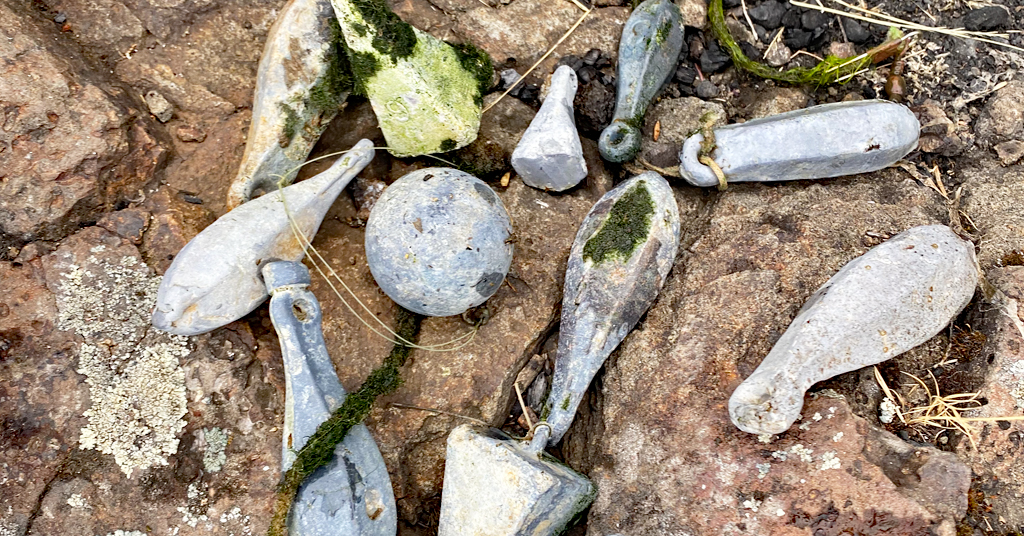
Catch of the day: It’s easy to bring up lead weights from the Columbia River. Photo: Mayo Archer
By Don Campbell. July 27, 2023. Archer Mayo holds a deep reverence for water. A windsurfer, scuba and free diver in the Columbia River Gorge, Mayo often swims with sturgeon, salmon, steelhead, lamprey and other inhabitants of the river.
As a salvage diver, Mayo also specializes in finding lost items. With his Underdog Dive Search/Recovery operation, based out of White Salmon, Wash., he’s spent years exploring the river and making other discoveries.
“Once I figured out that in certain places there are series of underwater cliffs that run parallel to the shore, I started free diving in the river,” Mayo, 54, tells Columbia Insight.
The experience has given him a deep knowledge of how the river runs and where its cliffs and odd geology exist—sand bars, pits and other dark, tough-to-access places.
These formations plague anglers who often get their lines hung up on crags, boulders and other rig-robbing outcrops.
“There’s almost never a time when [anglers] don’t lose a weight,” says Mayo.

Riverminder: Archer has been removing lead garbage from the Columbia River for over a decade. Photo: Mayo Archer
Mayo’s knowledge comes in handy for the many people who’ve lost valuables in the river. When that happens, they often call him to take a dive to find their submerged items—fishing rods, skateboards, precious jewelry, prescription glasses, Rolex watches, cell phones, even bikes, boats and automobiles.
All of this has led to Mayo to a weighty discovery—lead.
Turns out, there’s lots of it in the Columbia River.
What began with Mayo finding pockets of lead fishing weights and sinkers has turned into a crusade. Mayo wants the lead—and its toxic effects—out of the Columbia River.
That’s because exposure to lead has the same poisonous effects on fish and other wildlife as it does on humans.
In its 2009 State of the River Report, the EPA identified four classes of toxic contaminants of major concern in the Columbia River Basin. They were mercury, polychlorinated biphenyls (PCBs), DDT and polybrominated flame retardants.
Mayo believes lead (which the EPA report also mentioned as present in the river) deserves a spot on that list.
“Lead (Pb) is a highly toxic metal in aquatic environments,” according to a 2019 report published by the National Library of Medicine. “Fish are at the top of the food chain in most aquatic environments, and are the most susceptible to the toxic effects of Pb exposure.”
Among other problems, lead accumulation in fish tissues causes oxidative stress, which induces synaptic damage and neurotransmitter malfunction.
Lead ‘folk art’
“There are fishing weights from 12,000 years ago in the river,” says Mayo. “Indians would chip off basalt and tie it to cedar bark rope. It’s a necessary thing to get fish out of the river. A sinker is a wish for a fish. It’s like writing a note and sending it to heaven.”
Poetics aside, it’s the modern sinkers—ones made of lead—that have Mayo worried.
Since 2012, he’s done enough free diving that he can readily see the blue-green lead oxide.
“I know the physics of the rock where I can dig into silt and pull out handfuls,” he says.
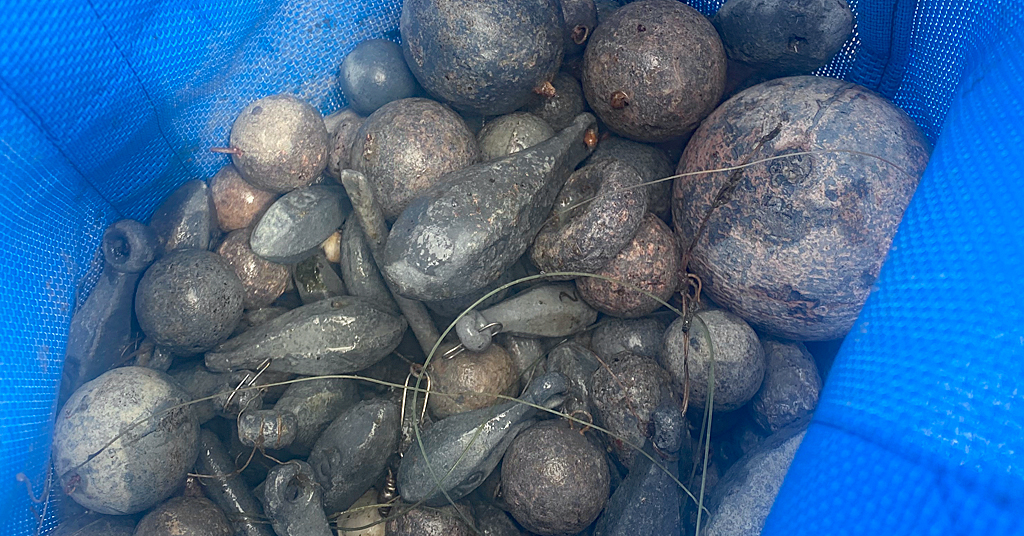
Garbage in, garbage out: Typical haul from one of Archer’s dives in the Columbia River. Photo: Mayo Archer
But he’s not just finding the common type of weights you might buy in any bait and tackle shop. Car batteries, spark plugs and other metal are common in the river.
“There’s a vernacular all its own,” Mayo says. “People make their own weights. People use spark plugs as weights. They use tire weights. It’s really crude.”
At some point, he began collecting some of the more unusual pieces.
“I’ve become a connoisseur of folk art,” he says. “I save interesting ones. They don’t go away. A piece of lead thrown in the river in 1919 is still as much ‘there’ as one that went in last week.”
Lead isn’t the only trouble in the river. His dives can be perilous for other reasons.
Always armed with a knife or paramedic shears, Mayo says he’s gotten into terrifying trouble when he’s encountered heavy-test line and “ghost nets” (largely invisible, damaged or abandoned fishing nets that haunt the water) in which he’s found himself dangerously entangled.
Mayo dives for more than lead and salvage.
For the past five years he’s been trying to solve the infamous disappearance of the Martins, a Portland family of five who vanished with their family car in the Columbia River Gorge in 1958. Police speculated that the family’s car likely crashed into the Columbia River, though details were never fully explained. The vehicle was never recovered.
“It was the largest manhunt in the history of the [Oregon] at that point and is still a cold case with possible foul play,” says Archer. “The nice thing about these and other mysteries is almost anywhere I dive in the river I can be getting fishing lead out at the same time.”
How much lead?
When Mayo began diving in the Columbia River, he spent most of his time around Cascade Locks, Ore., and the Spring Creek National Fish Hatchery near Underwood, Wash., where he lives.
He says he’s pulled up some 700 pounds of lead sinkers out of the Spring Creek hatchery area alone, often 12 pounds at time in a free dive.
“I’ve seen how much lead there is,” he says. “It gives me a reason to dive.”

Salvage master: Archer is also an expert free diver. Photo: Mayo Archer
Mayo shows a photo of a large, three-pound weight and a slew of lesser but more abundant 16- and 8-ounce weights he’s pulled from an area near Cascade Locks.
He unscientifically guesses that “there’s easily 10,000 pounds of lead [in the area]. I’m not exaggerating. I could probably get more.”
While he doesn’t describe himself as an activist, Mayo says he’s handled so much lead in the Columbia that he sees it as a bellwether of the river’s health.
“I’m doing this for the awareness,” he says. “There’s a badness level, and [my diving] is doing something good.”
Mayo would like to see the creation of an incentivized market for lead salvage, as well as public events that would encourage people to help haul up the heavy bounty.
To this end he’s hoping to begin an extraction program this fall that he’d like to call “Sinker Swim.”
He envisions the program as something similar to the Washington Fish & Wildlife Department’s Pikeminnow Sport-Reward Fishery Program, in which anglers on the Columbia and Snake Rivers are paid for each northern pikeminnow they catch from within program boundaries. (Northern pikeminnow are a native species that eat millions of juvenile salmon and steelhead each year in the Columbia and Snake River systems. The goal of the Pikeminnow Program isn’t to eradicate the fish, but to help salmon recovery by reducing the average size of northern pikeminnows by removing the larger fish from their population.)
Mayo also advocates for metallurgic alternatives to lead sinkers, including lead-free combinations of tin, bismuth, steel, ceramic and a tungsten-nickel alloy.
Since 1987, California has listed lead as a carcinogenic and reproductive toxin and has “banned the sale, manufacture and installation of lead wheel weights to help keep lead from leaching into water supplies and other parts of the environment,” according to the state’s Department of Toxic Substances Control.
Mayo says he’s approached the Columbia River Inter-Tribal Fish Commission (for whom he says he found and salvaged an $85,000 research vessel in 2019 that sank in turbulent weather in 2017) and the Washington Department of Fish and Wildlife about what could be done, but has gotten no official word back.
Still, Mayo is energized by his salvage and discovery efforts, and hopes others take heed.
“Lead,” he says, “is the low-hanging fruit.”
And there’s a lot more to harvest.



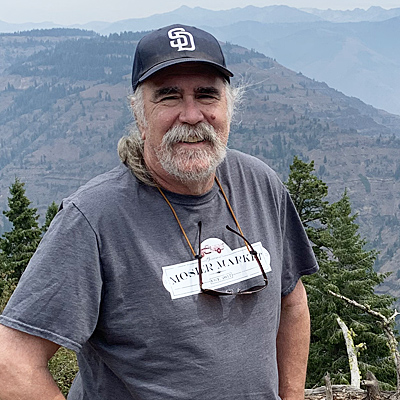
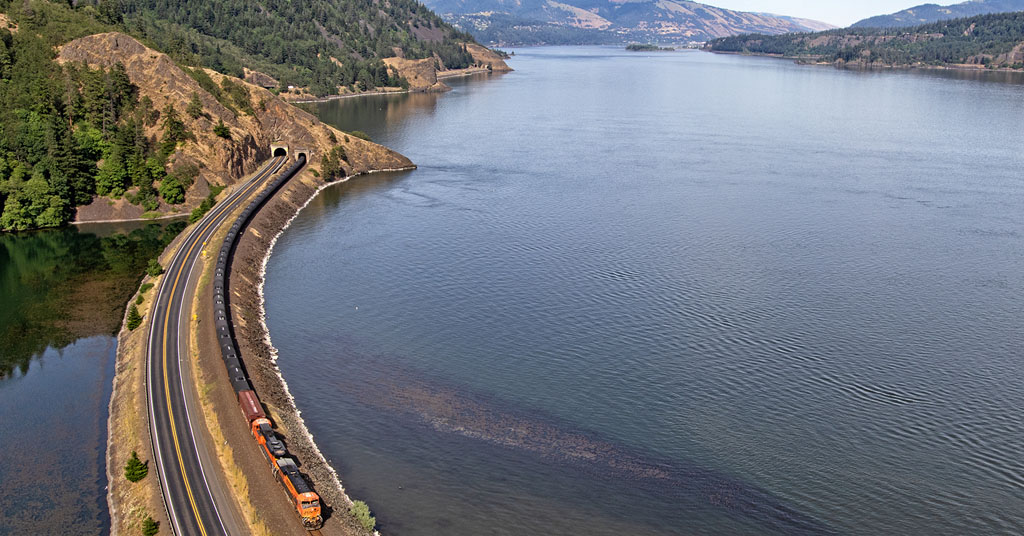
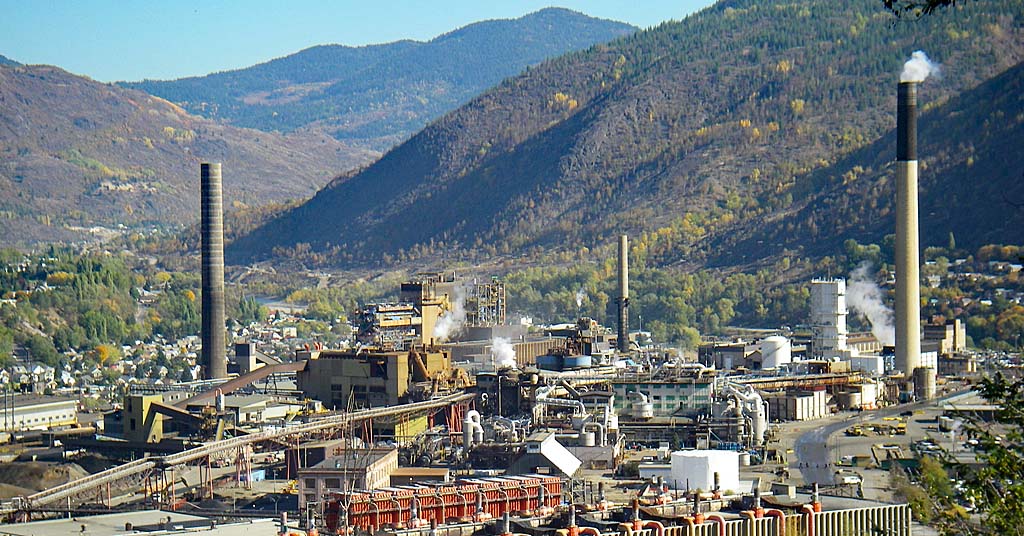

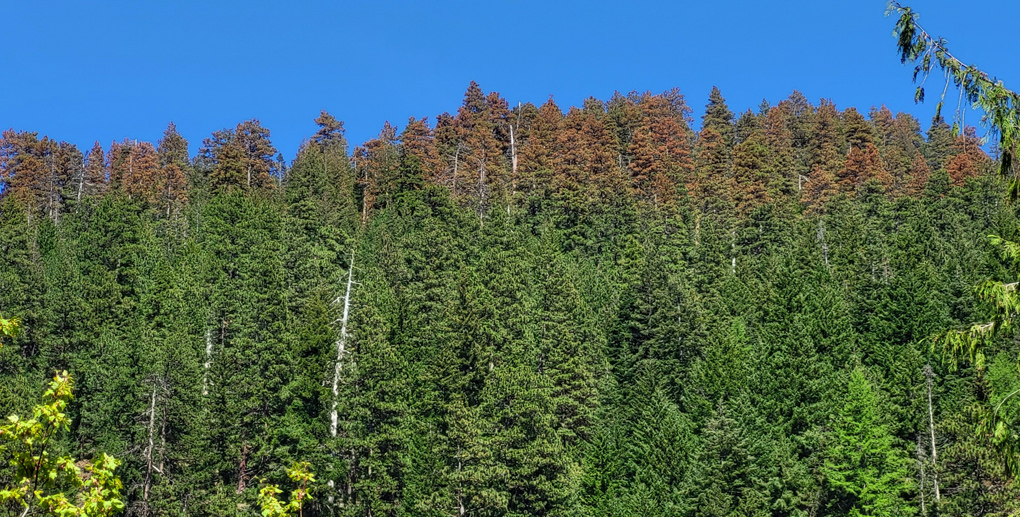



‘Look at progress then count the cost
We’ll spoil the seas with the rivers we’ve lost” Graeme Edge The Moody Blues 1979 Don’t You Feel Small
This is fear-mongering at its best. Maybe the author should do some calculating and have river water samples collected by a certified laboratory to see if lead is even detectable at parts-per-billion concentrations. Obviously from the pictures shown, the lead articles (weights) do not appear to have been in the process of dissolving into the Columbia’s flow. And, I expect that at the neutral pH of the River, a lead weight might take centuries to dissolve and the resulting lead in solution — at the Columbia’s 64 million gallons per minute flow — would be virtually non-detectable. Why not take some water samples, have them tested in a certified laboratory, and then compare the values to established fish toxicity thresholds before “crying wolf”?
Hi Alan: The 12th paragraph of this article includes a link to the EPA’s 2009 State of the River report, which includes information on lead found in the Columbia River following the analysis of water samples by EPA scientists. The report summarizes what was then known about four main contaminants in the Basin (mercury, polychlorinated biphenyls (PCBs), DDT, polybrominated flame retardants), as well as other contaminants. To quote from page 7 of the EPA study: “In addition to these four contaminants, many other contaminants of concern were also identified in the Basin. These included metals such as arsenic and lead.” I’ll add that, toxic or not, Columbia Insight applauds any removal and proper disposal of trash from natural environments. Thank you for your comment and for reading Columbia Insight. —Editor
“This is fear-mongering at its best.”
Huh, How many Pb parts per million of sky are needed to put a significant dent in waterfowl and raptors/scavengers?
FYI: https://columbiainsight.org/toxic-ammo-how-to-wean-hunters-from-lead-shot/
Yes, this is good information, and very familiar to me. I have done water quality assessment of lead from lost fishing sinkers and degrading publicly owned railroad bridges that are massively degrading, and dropping very large amounts of pure lead into the slightly acidic stream waters below. Coho salmon area a species listed as threatened, and many millions of dollars are being used to desperately try to improve their habitat in the Siuslaw watershed. The young fish that are increased in numbers then must swim downstream through the mid to lower river waters with elevated dissolved lead, and with particulate lead ground up into such fine colloidal sizes that the particles stay suspended for many miles. This can contact gill and gut tissues directly, to dissolve right on the tissue for higher dose. Our water here is often much more acidic than that of the Columbia, but lead dissolves up to about 8 pH, which is often lower in the Columbia. There is very strong governmental resistance to assessing this issue with scientific integrity, because of industry lobbies that fund elections. The science is very clear about very significant harms to fish exposed at these levels. The regulatory agencies will only be able to do the due diligence necessary if they get political nod that this is necessary! This will not happen, best hope is for the politic to come to understanding that economic craziness of harming the fish we love, and spend massive funds at salmon habitat restoration while we then allow poisoning them! AND, don’t get me started about the superfund sites that are the tackle boxes contaminated, and poisoning the grandkids of legislators who take them out to teach them how to fish. Apples, sandwiches, cooler ice, and fish get contaminated and put into frying pans. Also, be careful collecting sinkers, as lead DOES pass readily through skin, just does not attach to the red blood cells tested for. This is a huge issue for toxicology to educate all those who are lead-exposed, fish and people that fish. Buyer beware! Regulatory agencies are restricted from due diligence in this issue. IMHO
Lead exposures, at environmental significant levels described in our assessment, are well known to constitute problems for reducing abilities for fish, which IS a decline pressure for these populations. This is NEVER assessed adequately, because governmental ‘environmental protection agencies’ at state and federal levels are afraid to do so, and people that fish are harmed, but NOT told about such risks! I can provide a LOT of scientifically valid citations to back up this assertion, and high quality study designs can easily be confirmation with due diligence scientific integrity….. but are NOT allowed to be done. IMHO
When dams are removed, sediment behind them begins to move downstream. Lost lead objects, sinkers and boat anchors, will gradually move down to the bedrock of the stream just as gold would. Now, these of lead are more subjected to the moving bedlam dynamics. Riverine potholes in the rock act as mortar and pestle to grind the lead into smaller particulate, increasing surface area exponentially to dissolve faster, or drift downstream to contact gill and gut. Any dam removal could construct a bedrock trench ‘trap’ to gather the heavy sinkers in, and then would make periodic removal focussed and pointedly effective. But, the agencies responsible, will NOT do this, because it would clearly demonstrate the massive problem that fishing regulations continue to allow without paying attention to the toxicology. IMHO
Read the scientific literature on lead poisoning, or find someone who can explain it to you in detail. Many physiologic pathways toward disease are adversely affected in your body, and it is not any better for fish health.
And, one big adverse effect is that it drops IQ! It also is well documented to contribute to brain diseases like Parkinson’s and Alzheimer’s. Lots of misery around the world is the result of lead poisoning at all levels. Yet, we can’t seem to even find an alternative with which to weight our lines without poisoning those things and people we love.